The Fire and Smoke Model Evaluation Experiment—A Plan for Integrated, Large Fire–Atmosphere Field Campaigns
Abstract
1. Introduction
2. Approach—Field Campaigns
3. Coordinated Measurements
3.1. Fuels and Consumption
3.2. Fire Behavior and Energy
3.3. Plume Dynamics and Meteorology
3.4. Smoke Chemistry and Transport
4. Application to Model Evaluation and Development
Past Fire–Atmosphere Field Campaigns—Lessons Learned and Legacy Datasets
5. Summary
Supplementary Materials
Author Contributions
Funding
Acknowledgments
Conflicts of Interest
References
- Cruz, M.G.; Alexander, M.E. Uncertainty associated with model predictions of surface and crown fire rates of spread. Environ. Model. Softw. 2013, 47, 16–28. [Google Scholar] [CrossRef]
- Yao, J.; Brauer, M.; Henderson, S.B. Evaluation of a Wildfire Smoke Forecasting System as a Tool for Public Health Protection. Environ. Health Perspect. 2014, 121, 1142–1147. [Google Scholar] [CrossRef] [PubMed]
- Mandel, J.; Beezley, J.D.; Kochanski, A.K. Coupled atmosphere-wildland fire modeling with WRF 3.3 and SFIRE 2011. Geosci. Model Dev. 2011, 4, 591–610. [Google Scholar] [CrossRef]
- Mandel, J.; Amram, S.; Beezley, J.D.; Kelman, G.; Kochanski, A.K.; Kondratenko, V.Y.; Lynn, B.H.; Regev, B.; Vejmelka, M. Recent advances and applications of WRF-SFIRE. Nat. Hazards Earth Syst. Sci. 2014, 14, 2829–2845. [Google Scholar] [CrossRef]
- Filippi, J.B.; Bosseur, F.; Mari, C.; Lac, C.; Le Moigne, P.; Cuenot, B.; Veynante, D.; Cariolle, D.; Balbi, J.-H. Coupled atmosphere-wildland fire modelling. J. Adv. Model. Earth Syst. 2009, 1, 11. [Google Scholar] [CrossRef]
- Coen, J.L. Modeling Wildland Fires: A Description of the Coupled Atmosphere-Wildland Fire Environment Model (CAWFE). NCAR Technical Note; NCAR/TN-500+STR. 2013. Available online: http://nldr.library.ucar.edu/repository/collections/TECH-NOTE-000-000-000-866 (accessed on 19 January 2017).
- Coen, J.L.; Schroeder, W. Use of spatially refined remote sensing fire detection data to initialize and evaluate coupled weather-wildfire growth model simulations. Geophys. Res. Lett. 2013, 40, 1–6. [Google Scholar] [CrossRef]
- Achtemeier, G.L.; Goodrick, S.A.; Liu, Y.-Q.; Garcia-Menendez, F.; Hu, Y.; Odman, M.T. Modeling smoke plume-rise and dispersion from southern United States prescribed burns with Daysmoke. Atmosphere 2011, 2, 358–388. [Google Scholar] [CrossRef]
- Linn, R.R.; Reisner, J.; Colmann, J.J.; Winterkamp, J. Studying wildfire behavior using FIRETEC. Int. J. Wildland Fire 2002, 11, 233–246. [Google Scholar] [CrossRef]
- Mell, W.; Jenkins, M.A.; Gould, J.; Cheney, P. A physics-based approach to modeling grassland fires. Int. J. Wildland Fire 2007, 16, 1–22. [Google Scholar] [CrossRef]
- Fire Paradox Project, Vesta. Available online: http://www.mtda.fr/vesta (accessed on 15 January 2019).
- Riebau, A.R.; Fox, D.G. Joint Fire Science Program Smoke Science Plan; Final Report 10-C-01-01; Joint Fire Science Program: Boise, ID, USA, 2010.
- Larkin, N.K.; Stand, T.T.; Drury, S.A.; Raffuse, S.M.; Solomon, R.C.; O’Neill, S.M.; Huang, S.; Wheeler, N. Phase 1 of the Smoke and Emissions Model Intercomparison Project (SEMIP): Test Cases, Methods, and Analysis Results; Joint Fire Science Program: Boise, ID, USA, 2012; Volume 42.
- Brown, T.; Clements, C.; Larkin, N.; Anderson, K.; Butler, B.; Goodrick, S.; Ichoku, C.; Lamb, B.; Mell, R.; Ottmar, R.; et al. Validating the Next Generation of Wildland Fire and Smoke Models for Operational and Research Use—A National Plan; Report 13-S-01-01; Joint Fire Science Program: Boise, ID, USA, 2014.
- Prichard, S.J.; Ottmar, R.D. State of Fire Behavior Models and Their Application to Ecosystem and Smoke Management Issues. Special Report to SERDP. 2013. Available online: http://www.dtic.mil/dtic/tr/fulltext/u2/a624597.pdf (accessed on 22 January 2019).
- Ottmar, R.D.; Hiers, K.H.; Clements, C.B.; Butler, B.; Dickinson, M.B.; Potter, B.; O’Brien, J.J.; Hudak, A.T.; Rowell, E.M.; Zajkowski, T.J. Measurements, datasets and preliminary result from the RxCADRE project-2008, 2011 and 2012. Int. J. Wildland Fire 2016, 25, 1–9. [Google Scholar] [CrossRef]
- Warneke, C.; Schwarz, J.P.; Ryerson, T.; Crawford, J.; Dibb, J.; Lefer, B.; Roberts, J.; Trainer, M.; Murphy, D.; Brown, S.; et al. Fire Influence on Regional Global Environments and Air Quality (FIREX-AQ): A NOAA/NASA Interagency Intensive Study of North American Fires. 2018. Available online: https://www.esrl.noaa.gov/csd/projects/firex/whitepaper.pdf (accessed on 3 January 2019).
- Liu, Y.; Goodrick, S.; Achtemeier, G. The weather conditions for desired smoke plumes at a FASMEE burn site. Atmosphere 2018, 9, 259. [Google Scholar] [CrossRef]
- Kochanski, A.K.; Fournier, A.; Mandel, J. Experimental design of a prescribed burn instrumentation. Atmosphere 2018, 9, 296. [Google Scholar] [CrossRef]
- Ottmar, R.D.; Brown, T.J.; French, N.H.F.; Larkin, N.K. Fire and Smoke Model Evaluation Experiment (FASMEE) Study Plan; Final Report 15-S-01-01; Joint Fire Sciences Program: Boise, ID, USA, 2018.
- Parsons, R.A.; Mell, W.E.; McCauley, P. Linking 3D spatial models of fuels and fire: Effects of spatial heterogeneity on fire behavior. Ecol. Model. 2011, 222, 679–691. [Google Scholar] [CrossRef]
- Ottmar, R.D. Wildland fire emissions, carbon, carbon, and climate: Modeling fuel consumption. For. Ecol. Manag. 2014, 317, 41–50. [Google Scholar] [CrossRef]
- Hiers, J.K.; O’Brien, J.J.; Mitchell, R.J.; Grego, J.M.; Loudermilk, E.L. The wildland fuel cell concept: An approach to characterize fine-scale variation in fuels and fire in frequently burned longleaf pine forests. Int. J. Wildland Fire 2009, 18, 315–325. [Google Scholar] [CrossRef]
- Loudermilk, E.L.; Hiers, J.K.; O’Brien, J.J.; Mitchell, R.J.; Singhania, A.; Fernandez, J.C.; Cropper, W.P., Jr.; Slatton, K.C. Ground-based LIDAR: A novel approach to quantify fine-scale fuelbed characteristics. Int. J. Wildland Fire 2009, 18, 676–685. [Google Scholar] [CrossRef]
- Rowell, E.; Loudermilk, E.L.; Seielstad, C.; O’Brien, J.J. Using simulated 3D surface fuelbeds and terrestrial laser scan data to develop inputs to fire behavior models. Can. J. Remote Sens. 2016, 1–17. [Google Scholar] [CrossRef]
- Skowronski, N.S.; Clark, K.L.; Duveneck, M. Three-dimensional canopy fuel loading predicted using upward and downward sensing LiDAR systems. Remote Sens. Environ. 2011, 115, 703–714. [Google Scholar] [CrossRef]
- Hudak, A.T.; Kato, A.; Bright, B.C.; Loudermilk, E.L.; Ottmar, R.D.; Prichard, S.J.; Hawley, C.; Rowell, E.M.; Restaino, J. Towards spatially explicit quantification of pre- and post-fire fuels and fuel consumption from traditional and point cloud measurements. Forest Sci. 2019. under review. [Google Scholar]
- Hudak, A.T.; Bright, B.C.; Pokswinski, S.M.; Loudermilk, E.L.; O’Brien, J.J.; Hornsby, B.S.; Klauberg, C.; Silva, C.A. Mapping forest structure and composition from low density lidar for informed forest, fuel, and fire management at Eglin Air Force Base, Florida, USA. Can. J. Remote Sens. 2016, 42, 411–427. [Google Scholar] [CrossRef]
- Prichard, S.J.; Ottmar, R.D.; Anderson, G.K. CONSUME User’s Guide and Scientific Documentation. 2007. Available online: http://www.fs.fed.us/pnw/fera/research/smoke/consume/consume30_users_guide.pdf (accessed on 27 December 2018).
- Lutes, D.C. First Order Fire Effects Model Mapping Tool: FOFEM Version 6.1 User’s Guide; USDA Forest Service, Rocky Mountain Research Station: Fort Collins, CO, USA, 2016.
- Liu, Y.; Kochanski, A.; Baker, K.; Mell, W.; Linn, R.; Paugam, R.; Mandel, J.; Fournier, A.; Goodrick, S.; Achtemeier, G.; et al. Fire behavior and smoke modeling: Model improvement and measurement needs for next-generation operational smoke prediction systems. Int. J. Wildland Fire 2019. under review. [Google Scholar]
- Kremens, R.L.; Smith, A.M.; Dickinson, M.B. Fire metrology: Current and future directions in physics-based measurements. Fire Ecol. 2010, 6, 13–35. [Google Scholar] [CrossRef]
- Achtemeier, G.L.; Goodrick, S.A.; Liu, Y. Modeling multiple-core updraft plume rise for an aerial ignition prescribed burn by coupling Daysmoke with a cellular automata fire model. Atmosphere 2012, 3, 352–376. [Google Scholar] [CrossRef]
- Riggan, P.J.; Tissell, R.G.; Lockwood, R.N.; Brass, J.A.; Pereira, J.A.R.; Miranda, H.S.; Miranda, A.C.; Campos, T.; Higgins, R. Remote measurement of energy and carbon flux from wildfires in Brazil. Ecol. Appl. 2004, 14, 855–872. [Google Scholar] [CrossRef]
- Schroeder, W.; Ellicott, E.; Ichoku, C.; Ellison, L.; Dickinson, M.B.; Ottmar, R.; Clements, C.; Hall, D.; Ambrosia, V.; Kremens, R.L. Integrated active fire retrievals and biomass burning emissions using complementary near coincident ground, airborne and spaceborne sensor data. Remote Sens. Environ. 2013, 140, 719–730. [Google Scholar] [CrossRef]
- Dickinson, M.B.; Hudak, A.T.; Zajkowski, T.; Loudermilk, E.L.; Schroeder, W.; Ellison, L.; Kremens, R.L.; Holley, W.; Martinez, O.; Paxton, A.; et al. Measuring radiant emissions from entire prescribed fires with ground, airborne and satellite sensors–RxCADRE 2012. Int. J. Wildland Fire 2016, 25, 48–61. [Google Scholar] [CrossRef]
- Mathews, B.J.; Strand, E.K.; Smith, A.M.S.; Hudak, A.T.; Dickinson, M.B.; Kremens, R.L. Laboratory experiments to estimate interception of infrared radiation by tree canopies. Int. J. Wildland Fire 2016, 25, 1009–1014. [Google Scholar] [CrossRef]
- Peterson, D.; Wang, J.; Ichoku, C.; Hyer, E.; Ambrosia, V. A sub-pixel based calculation of fire radiative power from MODIS observations: 1 Algorithm development and initial assessment. Remote Sens. Environ. 2013, 129, 262–279. [Google Scholar] [CrossRef]
- Clements, C.B.; Lareau, N.; Seto, N.; Contezac, J.; Davis, B.; Teske, C.; Butler, B.; Jimenez, D. Meteorological measurements and fire weather conditions-RxCADRE 2012. Int. J. Wildland Fire 2016, 25, 90–101. [Google Scholar] [CrossRef]
- Clements, C.B.; Lareau, N.; Kingsmill, D.E.; Bowers, C.L.; Camacho, C.P.; Bagley, R.; Davis, B. RaDFIRE–The rapid deployments to wildfires experiment (RaDFIRE): Observations from the fire zone. Bull. Am. Meteorol. Soc. 2018, 99, 2539–2559. [Google Scholar] [CrossRef]
- Charland, C.M.; Clements, C.B. Kinematic structure of a wildland fire plume observed by Doppler lidar. J. Geophys. Res. Atmos. 2013, 118, 3200–3212. [Google Scholar] [CrossRef]
- Lareau, N.P.; Clements, C.B. The mean and turbulent properties of a wildfire convective plume. J. Appl. Meteorol. Climatol. 2017, 56, 2289–2299. [Google Scholar] [CrossRef]
- McCarthy, N.; McGowan, H.; Guyot, A.; Dowdy, A. Mobile E-POL Radar—A new tool for investigating pyroconvection and associated wildfire meteorology. Bull. Am. Meteorol. Soc. 2018, 99, 1177–1195. [Google Scholar] [CrossRef]
- Urbanski, S.P. Combustion efficiency and emission factors for US wildfires. Atmos. Chem. Phys. Discuss. 2013, 13, 33–78. [Google Scholar] [CrossRef]
- Yokelson, R.J.; Burling, I.R.; Gilman, J.B.; Warneke, C.; Stockwell, C.E.; de Gouw, J.; Akagi, S.K.; Urbanski, S.P.; Veres, P.; Roberts, J.M.; et al. Coupling field and laboratory measurements to estimate the emission factors of identified and unidentified trace gases for prescribed fires. Atmos. Chem. Phys. 2013, 13, 89–116. [Google Scholar] [CrossRef]
- Alvarado, M.J.; Lonsdale, C.R.; Yokelson, R.J.; Akagi, S.K.; Coe, H.; Craven, J.S.; Fischer, E.V.; McMeeking, G.R.; Seinfeld, J.H.; Soni, T.; et al. Investigating the links between ozone and organic aerosol chemistry in a biomass burning plume from a prescribed fire in California chaparral. Atmos. Chem. Phys. 2015, 15, 6667–6688. [Google Scholar] [CrossRef]
- Forrister, H.; Liu, J.; Scheuer, E.; Dibb, J.; Ziemba, L.; Thornhill, K.L.; Anderson, B.; Diskin, G.; Perring, A.E.; Schwarz, J.P.; et al. Evolution of brown carbon in wildfire plumes. Geophys. Res. Lett. 2015, 42, 4623–4630. [Google Scholar] [CrossRef]
- May, A.A.; Lee, T.; McMeeking, G.R.; Akagi, S.; Sullivan, A.P.; Urbanski, S.; Yokelson, R.J.; Kreidenweis, S.M. Observations and analysis of organic aerosol evolution in some prescribed fire smoke plumes. Atmos. Chem. Phys. 2015, 15, 6323–6335. [Google Scholar] [CrossRef]
- May, A.A.; McMeeking, G.R.; Lee, T.; Taylor, J.W.; Craven, J.S.; Burling, I.; Sullivan, A.P.; Akagi, S.; Collett, J.L., Jr.; Flynn, M.; et al. Aerosol emissions from prescribed fires in the United States: A synthesis of laboratory and aircraft measurements. J. Geophys. Res. Atmos. 2014, 119, 11826–11849. [Google Scholar] [CrossRef]
- Strand, T.; Gullett, B.; Urbanski, S.; O’Neill, S.; Potter, B.; Aurell, J.; Holder, A.; Larkin, N.; Moore, M.; Rorig., M. Grassland and forest understorey biomass emissions from prescribed fires in the southeastern United States–RxCADRE 2012. Int. J. Wildland Fire 2016, 25, 102–113. [Google Scholar] [CrossRef]
- Akagi, S.K.; Yokelson, R.J.; Wiedinmyer, C.; Alvarado, M.J.; Reid, J.S.; Karl, T.; Crounse, J.D.; Wennberg, P.O. Emission factors for open and domestic biomass burning for use in atmospheric models. Atmos. Chem. Phys. 2011, 11, 4039–4072. [Google Scholar] [CrossRef]
- Jaffe, D.; Wigder, N.L. Ozone production from wildfires: A critical review. Atmos. Environ. 2012, 51, 1–10. [Google Scholar] [CrossRef]
- Baker, K.; Woody, M.; Valin, L.; Szykman, J.; Yates, E.; Iraci, L.; Choi, H.; Soja, A.; Koplitz, S.; Zhou, L. Photochemical model evaluation of 2013 California wild fire air quality impacts using surface, aircraft, and satellite data. Sci. Total Environ. 2018, 637, 1137–1149. [Google Scholar] [CrossRef] [PubMed]
- Koss, A.R.; Sekimoto, K.; Gilman, J.B.; Selimovic, V.; Coggon, M.M.; Zarzana, K.J.; Yuan, B.; Lerner, B.M.; Brown, S.S.; Jimenez, J.L.; et al. Non-methane organic gas emission from biomass burning: Identification, quantification, and emissions factors from PTR-ToF during the FIREX 2016 laboratory experiment. Atmos. Chem. Phys. 2018, 18, 3299–3319. [Google Scholar] [CrossRef]
- Sengupta, D.; Samburova, V.; Bhattarai, C.; Kirilova, E.; Mazzoleni, L.; Iaukea-Lum, M.; Watts, A.; Moosmüller, H.; Khlystov, A. Light absorption by polar and non-polar aerosol compounds from laboratory biomass combustion. Atmos. Chem. Phys. 2018, 18, 10849–10867. [Google Scholar] [CrossRef]
- Sekimoto, K.; Koss, A.R.; Gilman, J.B.; Vanessa, S.; Matthew, M.C.; Kyle, J.Z.; Bin, Y.; Brian, M.L.; Steven, S.; Carsten, W.; et al. High- and low-temperature pyrolysis profiles describe volatile organic compound emissions from western US wildfire fuels. Atmos. Chem. Phys. Discuss. 2018, 18, 9263–9281. [Google Scholar] [CrossRef]
- Zhou, L.; Baker, K.R.; Napelenok, S.L.; Pouliot, G.; Elleman, R.; O’Neill, S.M.; Urbanski, S.P.; Wong, D.C. Modeling crop residue burning experiments to evaluate smoke emissions and plume transport. Sci. Total Environ. 2018, 627, 523–533. [Google Scholar] [CrossRef]
- Akagi, S.K.; Craven, J.S.; Taylor, J.W.; McMeeking, G.R.; Yokelson, R.J.; Burling, I.R.; Urbanski, S.P.; Wold, C.E.; Seinfeld, J.H.; Coe, H.; et al. Evolution of trace gases and particles emitted by a chaparral fire in California. Atmos. Chem. Phys. 2012, 12, 1397–1421. [Google Scholar] [CrossRef]
- Akagi, S.K.; Yokelson, R.J.; Burling, I.R.; Meinardi, S.; Simpson, I.; Blake, D.R.; McMeeking, G.R.; Sullivan, A.; Lee, T.; Kreidenweis, S.; et al. Measurements of reactive trace gases and variable O3 formation rates in some South Carolina biomass burning plumes. Atmos. Chem. Phys. 2013, 13, 1141–1165. [Google Scholar] [CrossRef]
- Cruz, M.G.; Alexander, M.E.; Sullivan, A.L. Mantras of wildland fire behavior modeling: Facts or fallacies? Int. J. Wildland Fire 2017, 26, 973–981. [Google Scholar] [CrossRef]
- Potter, B.E. Atmospheric interactions with wildland fire behaviour–I. Basic surface interactions, vertical profiles and synoptic structures. Int. J. Wildland Fire 2012, 21, 779–801. [Google Scholar] [CrossRef]
- Potter, B.E. Atmospheric interactions with wildland fire behaviour–II. Plume and vortex dynamics. Int. J. Wildland Fire 2012, 21, 802–817. [Google Scholar] [CrossRef]
- Larkin, N.K.; O’Neill, S.M.; Solomon, R.; Raffuse, S.; Strand, T.; Sullivan, D.C.; Ferguson, S.A. The BlueSky smoke modeling framework. Int. J. Wildland Fire 2010, 18, 906–920. [Google Scholar] [CrossRef]
- Andrews, P.L. Do you BEHAVE?—Application of the BehavePlus fire modeling system. In Proceedings of the 3rd Fire Behavior and Fuels Conference, Spokane, WA, USA, 25–29 October 2010. [Google Scholar]
- Andrews, P.L. BEHAVE: Fire Behavior Prediction and Fuel Modeling System-Burn Subsystem, Part 1; Gen Tech. Rep. INT-194; U.S. Department of Agriculture, Forest Service, Intermountain Research Station: Ogden, UT, USA, 1986.
- Reinhardt, E.D.; Keane, R.E.; Brown, J.K. First Order Fire Effects Model: FOFEM 4.0, Users Guide; INT-GTR-344; USDA Forest Service, Intermountain Research Station: Ogden, UT, USA, 1997.
- Finney, M.A. An Overview of FlamMap Fire Modeling Capabilities. In Proceedings of the Fuels Management-How to Measure Success: Conference 28–30 March 2006; U.S. Department of Agriculture, Forest Service, Rocky Mountain Research Station: Fort Collins, CO, USA, 2006; pp. 213–220. [Google Scholar]
- US Forest Service. VSmoke. Available online: https://webcam.srs.fs.fed.us/tools/vsmoke (accessed on 15 January 2019).
- Stein, A.F.; Draxler, R.R.; Rolph, G.D.; Stunder, B.J.B.; Cohen, M.D.; Ngan, F. NOAA’s HYSPLIT atmospheric transport and dispersion modeling system. Bull. Am. Meteorol. Soc. 2015, 96, 2059–2077. [Google Scholar] [CrossRef]
- Briggs, G.A. Discussion on chimney plumes in neutral and stable surroundings. Atmos. Environ. 1972, 6, 507–510. [Google Scholar] [CrossRef]
- Briggs, G.A. Plume Rise; AEC Critical Review Series; National Technical Information Service: Springfield, VA, USA, 1969; Volume TID-25075.
- Stratton, R.D. Guidance on Spatial Wildland Fire Analysis: Models, Tools, and Techniques; RMRS-GTR-183; USDA Forest Service, Rocky Mountain Research Station: Fort Collins, CO, USA, 2006.
- Bradshaw, L.; McCormick, E. Fire Family Plus User’s Guide, Version 2.0; RMRS-GTR-67; USDA Forest Service, Rocky Mountain Research Station: Fort Collins, CO, USA, 2000.
- Short, K.C.; Finney, M.A.; Scott, J.H.; Gilbertson-Day, J.W.; Grenfell, I.C. Spatial Dataset of Probabilistic Wildfire Risk Components for the Conterminous United States; Forest Service Research Data Archive: Fort Collins, CO, USA, 2016.
- Forthofer, J.M.; Butler, B.W.; Wagenbrenner, N.S. A comparison of three approaches for simulating fine-scale surface winds in support of wildland fire management. Part I. Model formulation and comparison against measurements. Int. J. Wildland Fire 2014, 23, 969–981. [Google Scholar] [CrossRef]
- Exponent, Inc. CALPUFF. Available online: http://www.src.com (accessed on 15 January 2019).
- US Environmental Protection Agency, CMAQ. Available online: https://www.epa.gov/cmaq (accessed on 15 January 2019).
- Alexander, M.E.; Stocks, B.J.; Wotton, B.M.; Lanoville, R.A. An example of multi-faceted wildland fire research: The International Crown Fire Modeling Experiment. In Proceedings of the 3rd International Conference on Forest Fire Research, Coimbra, Portugal, 16–19 November 1998. [Google Scholar]
- Stocks, B.J.; Alexander, M.E.; Lanoville, R.A. Overview of the International Crown Fire Modeling Experiment (ICFME). Can. J. For. Res. 2004, 34, 1543–1547. [Google Scholar] [CrossRef]
- FIRESCAN Science Team. Fire in Ecosystems of Boreal Eurasia: The Bor Forest Island Fire Experiment, Fire Research Campaign Asia-North (FIRESCAN); Levine, J.S., Ed.; Biomass burning and global change; The MIT Press: Cambridge, MA, USA, 1996; Volume II. [Google Scholar]
- Hinzman, L.D.; Fukuda, M.; Sandberg, D.V.; Chapin, F.S., III; Dash, D. FROSTFIRE: An experimental approach to predicting the climate feedbacks from the changing boreal fire regime. J. Geophys. Res. 2002, 108, 8153. [Google Scholar] [CrossRef]
- Kochanski, A.K.; Jenkins, M.A.; Mandel, J.; Beezley, J.D.; Clements, C.B.; Krueger, S. Evaluation of WRF-SFIRE performance with field observations from the FireFlux experiment. Geosci. Model Dev. 2013, 6, 1109–1126. [Google Scholar] [CrossRef]
- Clements, C.B.; Zhong, S.; Goodrick, S.; Li, J.; Bian, X.; Potter, B.E.; Heilman, W.E.; Charney, J.J.; Perna, R.; Jang, M.; et al. Observing the Dynamics of Wildland Grass Fires: FireFlux- A Field Validation Experiment. Bull. Am. Meteorol. Soc. 2007, 88, 1369–1382. [Google Scholar] [CrossRef]
- Clements, C.B.; Zhong, S.; Bian, X.; Heilman, W.E.; Byun, D.W. First observations of turbulence generated by grass fires. J. Geophys. Res. 2008, 113, D22102. [Google Scholar] [CrossRef]
- Clements, C.B. Thermodynamic structure of a grass fire plume. Int. J. Wildland Fire 2010, 19, 895–902. [Google Scholar] [CrossRef]
- US Forest Service Research Data Archive. Available online: http://www.fs.usda.gov/rds/archive (accessed on 15 January 2019).
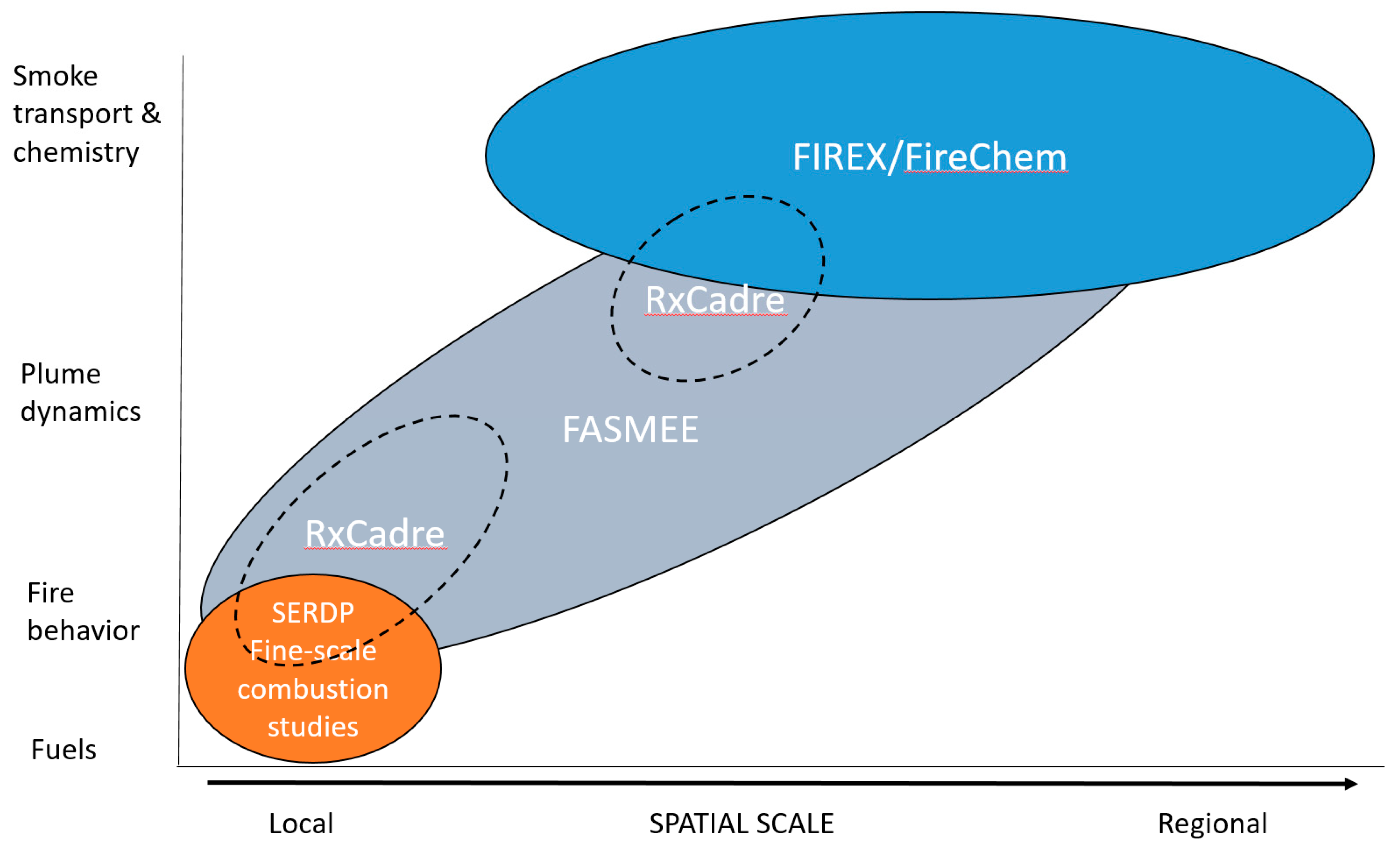
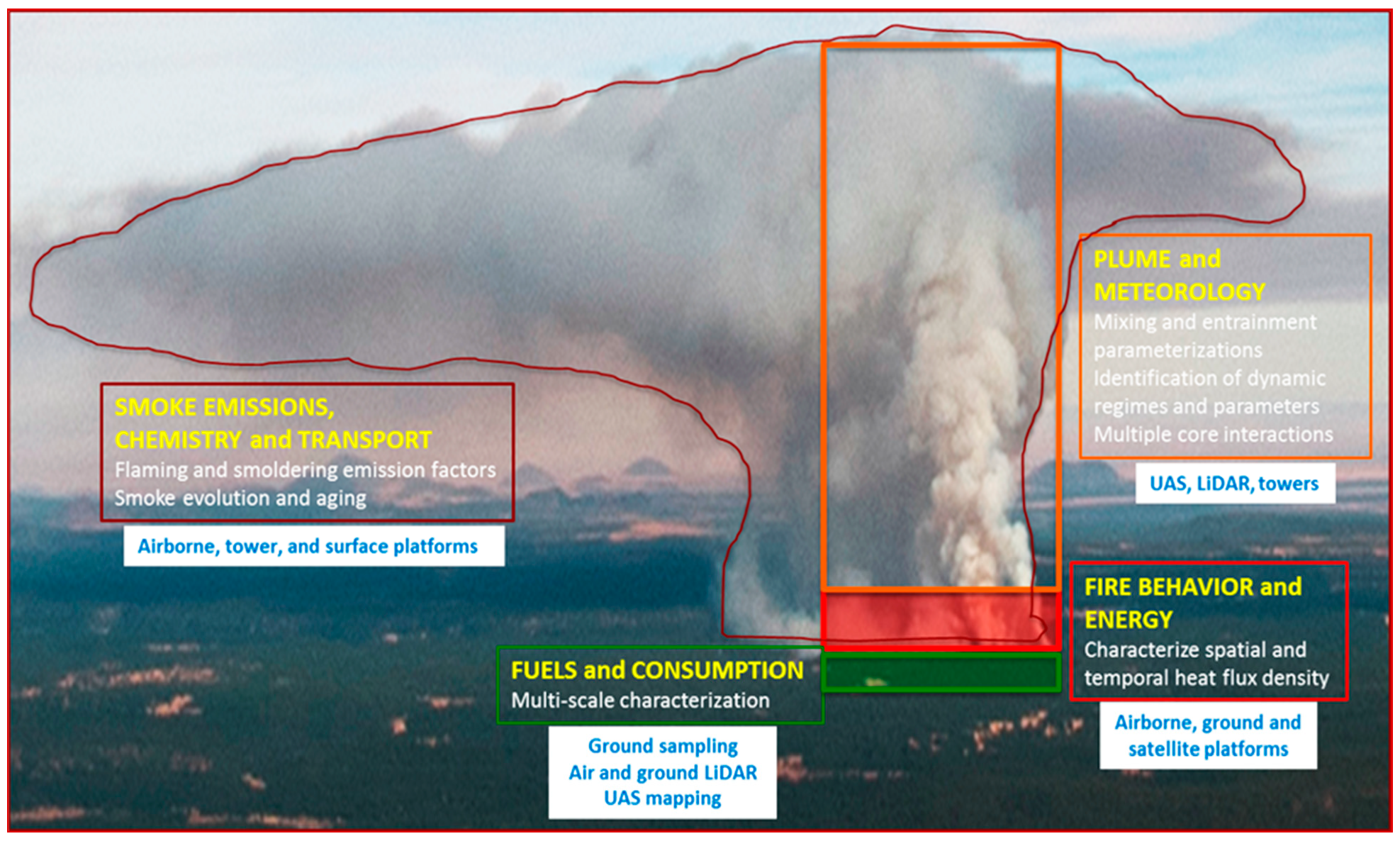
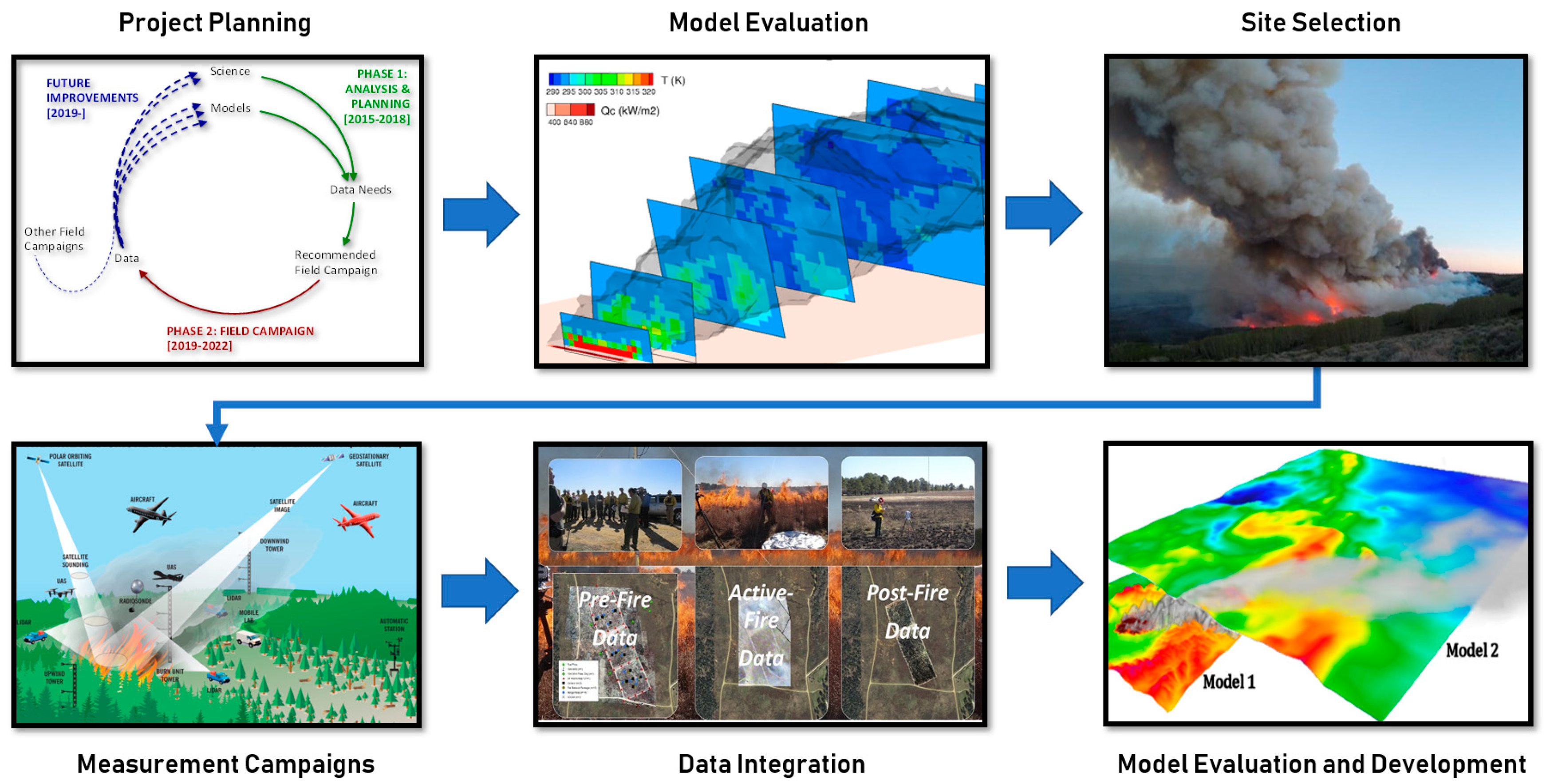
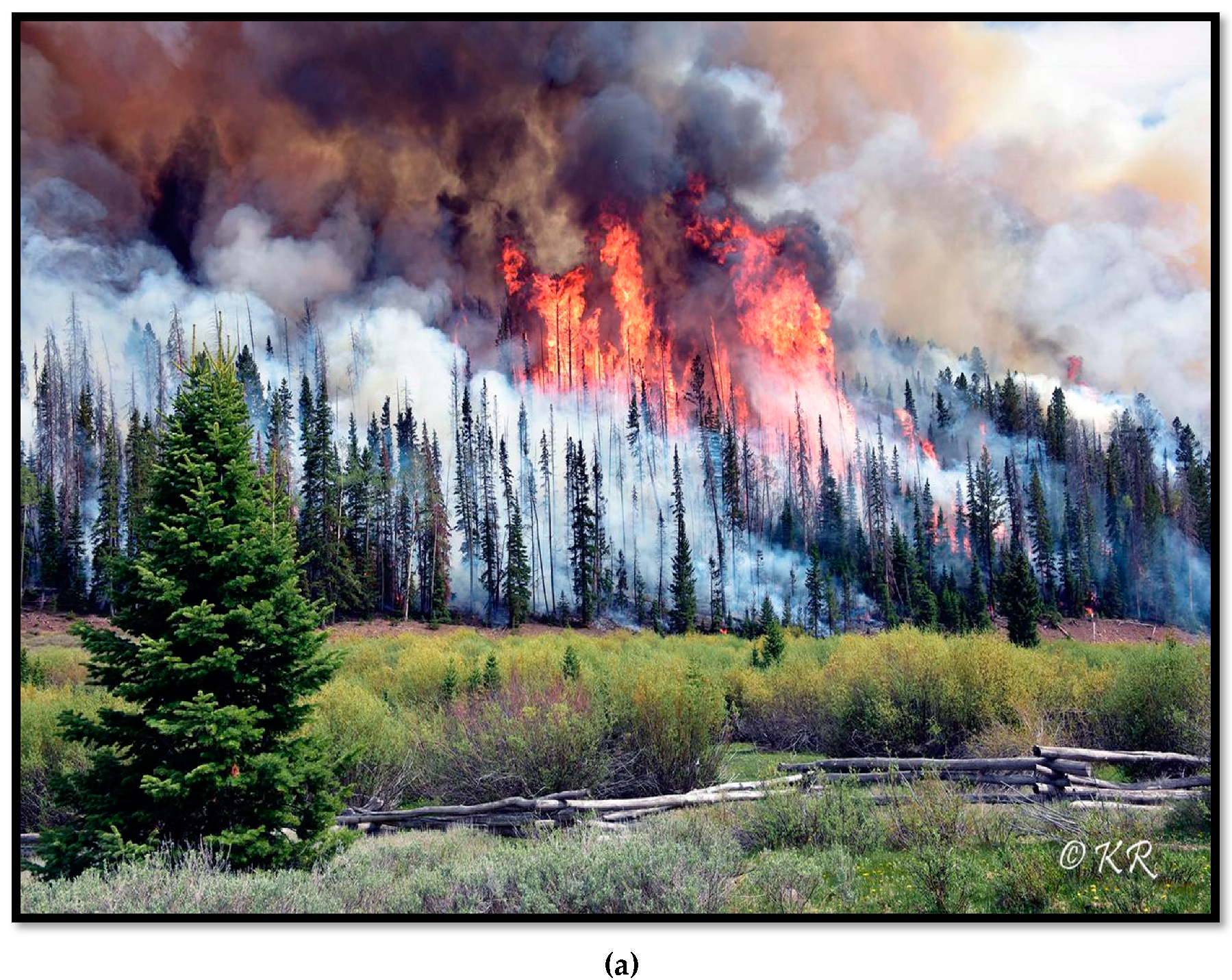
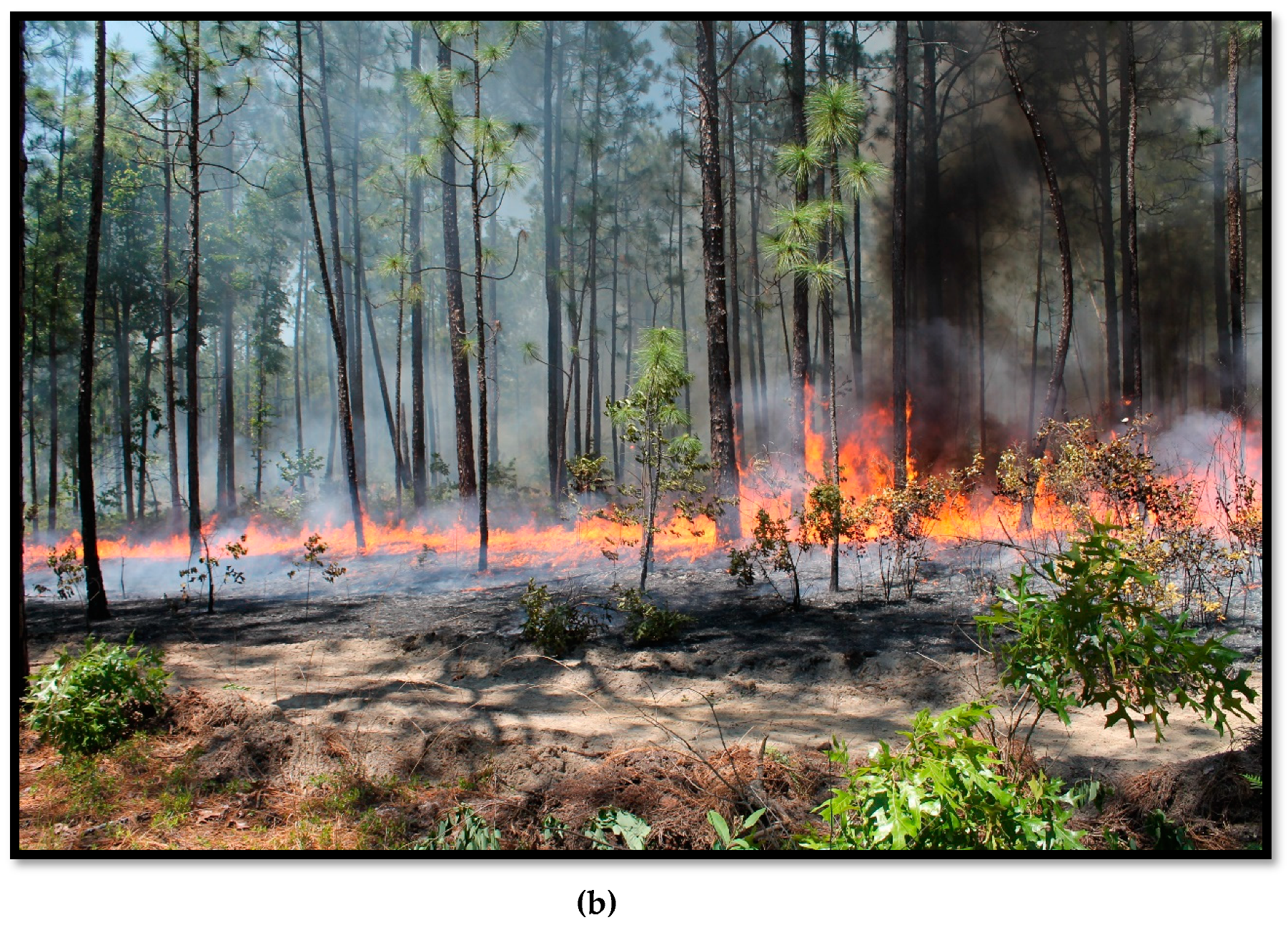
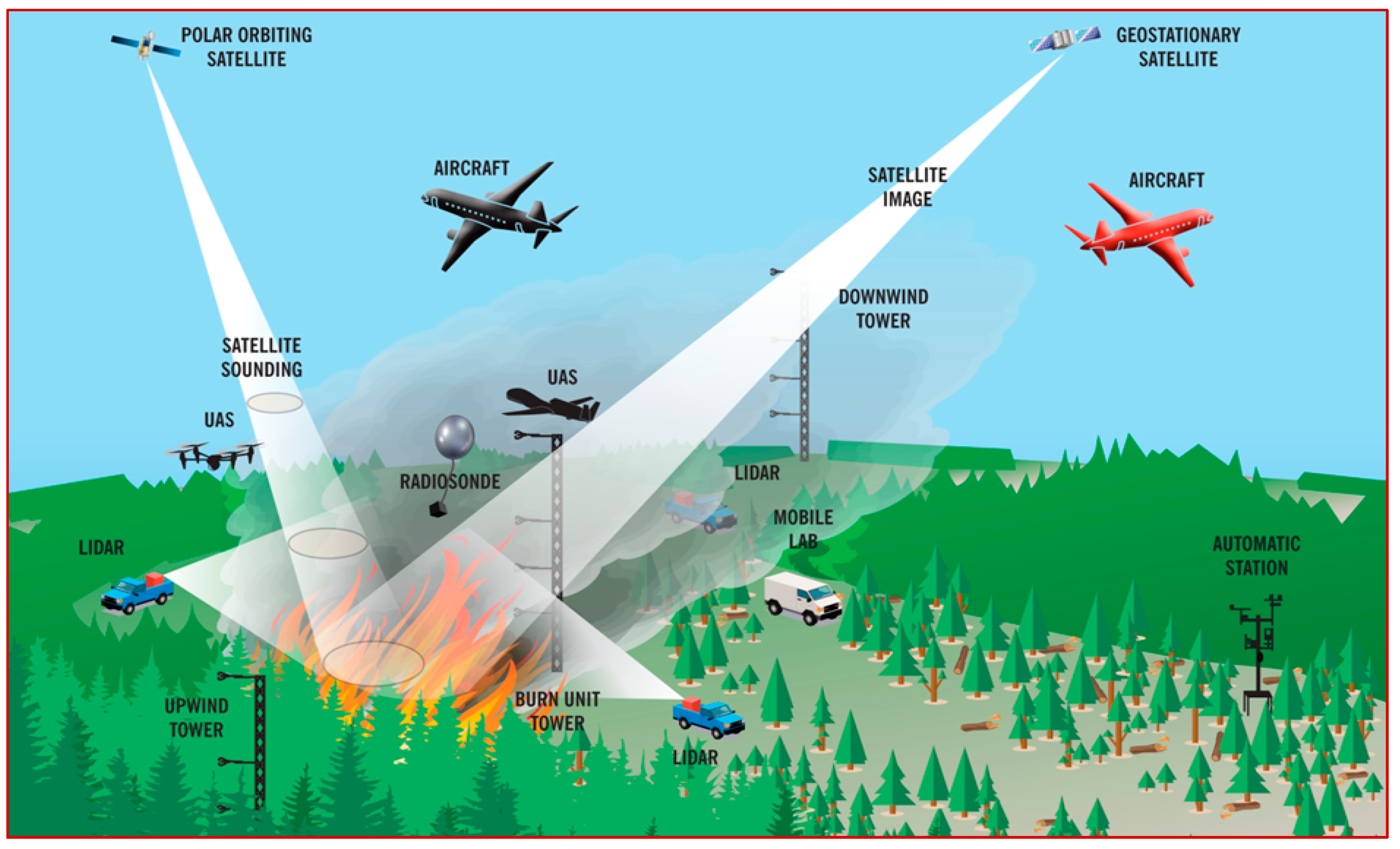
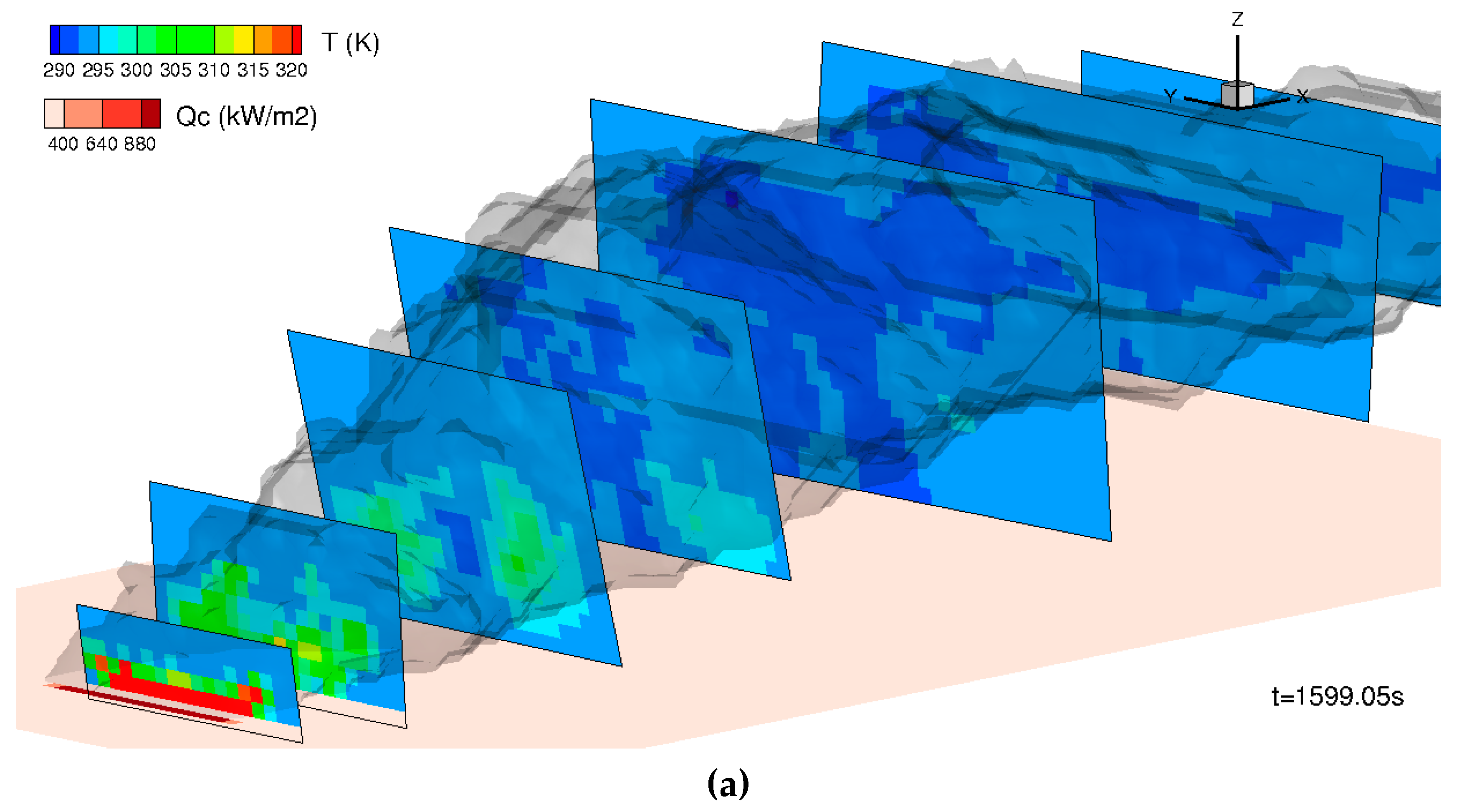
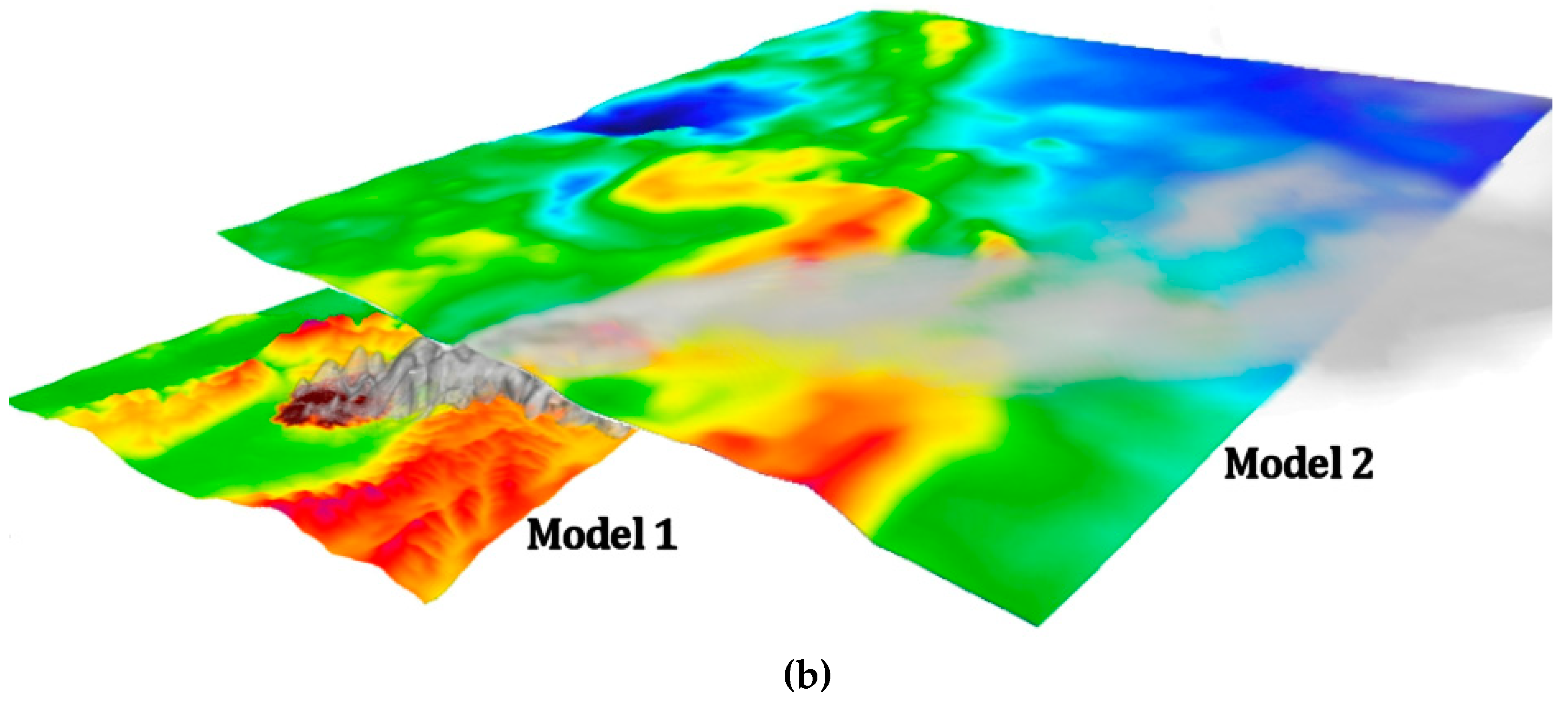
| Model | Description | Applications | FASMEE Datasets | References |
|---|---|---|---|---|
| CAWFE | Coupled Atmosphere-Wildland Fire-Environment (CAWFE): a coupled weather—wildland fire computational model. | NCAR Simulation model (Janice Coen) | Fire behavior, meteorology and plume dynamics. | [7] |
| FIRETEC | HIGRAD/FIRETEC: physics-based, 3-D model that represents the coupled interaction between fire, fuels, atmosphere, and topography. | Simulation Model, Los Alamos National Laboratory, included in STANDFIRE | Fuel consumption, gridded fire behavior and radiative energy, meteorology and plume dynamics. | [9] |
| MesoNH/ ForeFire | Mesoscale non-hydrostatic model coupled with a surface atmospheric interaction model (SURFEX). | Desktop (unix) | Meteorology and plume dynamics | [5] |
| Vesta | Large-scale, cell-based wildland fire simulator developed within the Fire Paradox project. | Desktop | Gridded fire behavior and fire radiative energy observations. | [11] |
| WFDS | Wildland-Urban-Interface Fire Dynamics Simulator: computational fluid dynamics model that resolves buoyant flow, heat transfer, combustion, and thermal fuel degradation. | Desktop (unix) STANDFIRE (under development) | Fuel consumption, gridded fire behavior and radiative energy, meteorology and plume dynamics. | [10] |
| WRF-SFIRE (Spread FIRE model) | Weather Research and Forecasting—Spread Fire: combined atmosphere and fire spread model. | High performance computing cluster | Gridded fire behavior, meteorology and plume dynamics. | [3,4] |
| Campaign and Timeline | Potential Sites | Description |
|---|---|---|
| Coordination with WE-CAN and FIREX-AQ large aircraft campaigns (July–August 2018 and 2019) | US wildfires and prescribed burns | FASMEE is collaborating with two large-scale campaigns to provide source characterization for emission studies from western wildfires (WE-CAN, https://www.eol.ucar.edu/field_projects/we-can) and US wildfires and prescribed burns (FIREX-AQ) |
| Southeast (planned) | Fort Stewart Savannah River Site | Highly instrumented prescribed underburns completed in managed pine forests with heavy surface fuel loads, ignited for a moderate-intensity fire |
| Southwest (planned) | Fishlake National Forest Kaibab National Forest | Moderately and highly instrumented prescribed burns in dense mixed conifer-aspen forests, ignited for a high-intensity, stand-replacement fire |
| Model | Description | Applications | FASMEE Datasets | Reference |
|---|---|---|---|---|
| BehavePlus | Models surface and crown fire spread and intensity, safety zone and point source size, fire containment, spotting distance, crown scorch height, tree mortality, and probability of ignition. | Desktop FFE-FVS Fire Family Plus Wildland Fire Decision Support System | Fire intensity; spread rate | [64,65] |
| CONSUME | Predicts consumption and emissions by combustion phase and fuelbed category. | BlueSky Fuel and Fire Tools IFTDSS | Consumption by category: flaming, smoldering and long-term smoldering combustion. | [29] |
| DaySmoke | Models smoke transport and dispersion. | Desktop | Plume rise; short-term smoke transport | [8] |
| FARSITE | Fire Area Simulator (FARSITE) spatially and temporally simulates fire spread and behavior under heterogeneous conditions. | Desktop WFDSS | Fire area & perimeter; spread rate; | [72] |
| FireFamily Plus (FFP) | Fire climatology and occurrence program; summarizes and analyzes weather observations and computes fire danger indices. | Desktop | Meteorological observations | [73] |
| First Order Fire Effects Model (FOFEM) | Predicts tree mortality, fuel consumption, smoke production, and soil heating. | Desktop IFTDSS module | Consumption by category; tree mortality; soil heating. | [30] |
| Fire Simulation Model (FireSim) Fire Spread Probability (FSPro) | Geospatial probabilistic model that predicts fire growth; designed to support long-term decision-making. | Desktop WFDSS module | Fire area; perimeter | [74] |
| FlamMap | Fire behavior mapping and analysis program that computes potential fire behavior characteristics. | Desktop IFTDSS, WFDSS | Fireline intensity; spread rate. | [67] |
| WindNinja | Computes spatially varying wind fields for wildland fire application. | WFDSS module | Gridded wind fields | [75] |
| HYSPLIT | Computes simple air parcel trajectories, as well as complex transport, dispersion, chemical transformation, and deposition simulations. | BlueSky; desktop; atmospheric modeling systems. | Smoke dispersion | [69] |
| CALPUFF | Non-steady-state meteorological and air quality modeling system. | Desktop | Meteorology; plume rise; smoke dispersion | [76] |
| CMAQ | Eulerian chemical transport model treating all emission sources, transport, chemical transformation, and deposition processes to estimate 03, speciated PM2.5, and toxics. | Unix-based computer system | Meteorology; plume rise; smoke dispersion; smoke chemistry | [77] |
| VSmoke | Smoke dispersion model to estimate prescribed fire impacts | Web-based Desktop | Plume rise; smoke dispersion | [68] |
© 2019 by the authors. Licensee MDPI, Basel, Switzerland. This article is an open access article distributed under the terms and conditions of the Creative Commons Attribution (CC BY) license (http://creativecommons.org/licenses/by/4.0/).
Share and Cite
Prichard, S.; Larkin, N.S.; Ottmar, R.; French, N.H.F.; Baker, K.; Brown, T.; Clements, C.; Dickinson, M.; Hudak, A.; Kochanski, A.; et al. The Fire and Smoke Model Evaluation Experiment—A Plan for Integrated, Large Fire–Atmosphere Field Campaigns. Atmosphere 2019, 10, 66. https://doi.org/10.3390/atmos10020066
Prichard S, Larkin NS, Ottmar R, French NHF, Baker K, Brown T, Clements C, Dickinson M, Hudak A, Kochanski A, et al. The Fire and Smoke Model Evaluation Experiment—A Plan for Integrated, Large Fire–Atmosphere Field Campaigns. Atmosphere. 2019; 10(2):66. https://doi.org/10.3390/atmos10020066
Chicago/Turabian StylePrichard, Susan, N. Sim Larkin, Roger Ottmar, Nancy H.F. French, Kirk Baker, Tim Brown, Craig Clements, Matt Dickinson, Andrew Hudak, Adam Kochanski, and et al. 2019. "The Fire and Smoke Model Evaluation Experiment—A Plan for Integrated, Large Fire–Atmosphere Field Campaigns" Atmosphere 10, no. 2: 66. https://doi.org/10.3390/atmos10020066
APA StylePrichard, S., Larkin, N. S., Ottmar, R., French, N. H. F., Baker, K., Brown, T., Clements, C., Dickinson, M., Hudak, A., Kochanski, A., Linn, R., Liu, Y., Potter, B., Mell, W., Tanzer, D., Urbanski, S., & Watts, A. (2019). The Fire and Smoke Model Evaluation Experiment—A Plan for Integrated, Large Fire–Atmosphere Field Campaigns. Atmosphere, 10(2), 66. https://doi.org/10.3390/atmos10020066







